Exploring the Effects of the Substitution of Freshly Mined Sands with Recycled Crushed Glass on the Properties of Concrete
Abstract
Featured Application
Abstract
1. Introduction
2. Waste Glass as Resource for Construction Materials
2.1. Waste Glass
- Sodium lime glasses (packaging glass)
- Borosilicate glasses
- Leaded glasses
- Barium glasses
- Aluminosilicates.
- SiO2 70–72%
- CaO 9–12%
- Na2O + K2O 8–10%
- Others Al2O3, Fe2O3, MgO.
2.2. Glass Wastes as Cementitious Substitutions
2.3. Glass Wastes as Aggregate Substitutions
3. Materials and Methods
3.1. Materials
3.2. Scanning Electron Microscopy
3.3. Concrete Mix Design
3.4. Wet Concrete Properties
3.4.1. Slump Cone Test
3.4.2. Density Measurements
3.5. Physical and Mechanical Properties
3.5.1. Water Absorption and Porosity
3.5.2. Compressive Strength
3.5.3. Flexural Test
3.5.4. Modulus of Elasticity
4. Results and Discussion
4.1. Sieve Analysis of Raw Materials
4.2. Fresh Concrete Properties
4.2.1. Slump
4.2.2. Fresh Density
4.3. Hardened Concrete Properties
4.3.1. Density
4.3.2. Water Absorptivity and Porosity
4.3.3. Compressive Strength
4.3.4. Splitting Tensile Strength
4.3.5. Flexural Strength
4.3.6. Modulus of Elasticity
4.4. SEM Analysis and Effects of Glass Substitution on Mechanical Properties
5. Conclusions
Author Contributions
Funding
Institutional Review Board Statement
Informed Consent Statement
Data Availability Statement
Acknowledgments
Conflicts of Interest
References
- Scrivener, K.L.; John, V.M.; Gartner, E.M. Eco-efficient cements: Potential economically viable solutions for a low-CO2 cement-based materials industry. Cem. Concr. Res. 2018, 114, 2–26. [Google Scholar] [CrossRef]
- Perera, S.; Arulrajah, A.; Wong, Y.C.; Horpibulsuk, S.; Maghool, F. Utilizing recycled PET blends with demolition wastes as construction materials. Constr. Build. Mater. 2019, 221, 200–209. [Google Scholar] [CrossRef]
- Batayneh, M.; Marie, I.; Asi, I. Use of selected waste materials in concrete mixes. Waste Manag. 2007, 27, 1870–1876. [Google Scholar] [CrossRef]
- Duan, Z.H.; Singh, A.; Xiao, J.Z.; Hou, S.D. Combined use of recycled powder and recycled coarse aggregate derived from construction and demolition waste in self-compacting concrete. Constr. Build. Mater. 2020, 254, 119323. [Google Scholar] [CrossRef]
- Nassar, R.U.D.; Soroushian, P. Strength and durability of recycled aggregate concrete containing milled glass as partial replacement for cement. Constr. Build. Mater. 2012, 29, 368–377. [Google Scholar] [CrossRef]
- Sormunen, P.; Karki, T. Recycled construction and demolition waste as a possible source of materials for composite manufacturing. J. Eng. Build. Eng. 2019, 24, 100742. [Google Scholar] [CrossRef]
- Yang, S.Q.; Lu, J.X.; Poon, C.S. Recycling of waste glass in dry-mixed concrete blocks: Evaluation of alkali-silica reaction (ASR) by accelerated laboratory tests and long-term field monitoring. Constr. Build. Mater. 2020, 262, 120865. [Google Scholar] [CrossRef]
- Australian Government, Department of Agriculture, Water and Environment. National Waste Report 2018. Available online: https://www.environment.gov.au/protection/waste/publications/national-waste-reports/2018 (accessed on 24 March 2021).
- Jiao, Y.B.; Zhang, Y.; Guo, M.; Zhang, L.D.; Ning, H.; Liu, S.Q. Mechanical and fracture properties of ultra-high performance concrete (UHPC) containing waste glass sand as partial replacement material. J. Clean. Prod. 2020, 277, 123501. [Google Scholar] [CrossRef]
- Ali, E.E.; Al-Tersawy, S.H. Recycled glass as a partial replacement for fine aggregate in self compacting concrete. Constr. Build. Mater. 2012, 35, 785–791. [Google Scholar] [CrossRef]
- Chen, C.H.; Huang, R.; Wu, J.K.; Yang, C.C. Waste E-glass particles used in cementitious mixtures. Cem. Conc. Res. 2006, 36, 449–456. [Google Scholar] [CrossRef]
- He, Z.H.; Yang, Y.; Zeng, H.; Chang, J.Y.; Shi, J.Y.; Liu, B.J. Waste glass powder and its effect on the fresh and mechanical properties of concrete: A state of the art review. Adv. Concr. Constr. 2020, 10, 417–429. [Google Scholar]
- Malek, M.; Lasica, W.; Jackowski, M.; Kadela, M. Effect of Waste Glass Addition as a Replacement for Fine Aggregate on Properties of Mortar. Materials 2020, 13, 3189. [Google Scholar] [CrossRef]
- Mohajerani, A.; Vajna, J.; Cheung, T.H.H.; Kurmus, H.; Arulrajah, A.; Horpibulsuk, S. Practical recycling applications of crushed waste glass in construction materials: A review. Constr. Build. Mater. 2017, 156, 443–467. [Google Scholar] [CrossRef]
- Bueno, E.T.; Paris, J.M.; Clavier, K.A.; Spreadbury, C.; Ferraro, C.C.; Townsend, T.G. A review of ground waste glass as a supplementary cementitious material: A focus on alkali-silica reaction. J. Clean. Prod. 2020, 257, 120180. [Google Scholar] [CrossRef]
- Guo, P.W.; Meng, W.N.; Nassif, H.; Gou, H.Y.; Bao, Y. New perspectives on recycling waste glass in manufacturing concrete for sustainable civil infrastructure. Constr. Build. Mater. 2020, 257, 119579. [Google Scholar] [CrossRef]
- Park, S.B.; Lee, B.C.; Kim, J.H. Studies on mechanical properties of concrete containing waste glass aggregate. Cem. Conc. Res. 2004, 34, 2181–2189. [Google Scholar] [CrossRef]
- Pereira-De-Oliveira, L.A.; Castro-Gomes, J.P.; Santos, P.M.S. The potential pozzolanic activity of glass and red-clay ceramic waste as cement mortars components. Constr. Build. Mater. 2012, 31, 197–203. [Google Scholar] [CrossRef]
- Ho, H.J.; Iizuka, A.; Shibata, E. Chemical recycling and use of various types of concrete waste: A review. J. Clean. Prod. 2021, 284, 124785. [Google Scholar] [CrossRef]
- Idir, R.; Cyr, M.; Tagnit-Hamou, A. Pozzolanic properties of fine and coarse color-mixed glass cullet. Cem. Concr. Compos. 2011, 33, 19–29. [Google Scholar] [CrossRef]
- Kumar, S.; Djobo, J.N.Y.; Kumar, A.; Kumar, S. Size fractionation of brown fly ash: Utilisation of grey fraction as a pozzolanic material in blended cement. Eur. J. Environ. Civil Eng. 2020, 24, 833–848. [Google Scholar] [CrossRef]
- Schwarz, N.; Cam, H.; Neithalath, N. Influence of a fine glass powder on the durability characteristics of concrete and its comparison to fly ash. Cem. Concr. Compos. 2008, 30, 486–496. [Google Scholar] [CrossRef]
- Afshinnia, K.; Rangaraju, P.R. Impact of combined use of ground glass powder and crushed glass aggregate on selected properties of Portland cement concrete. Constr. Build. Mater. 2016, 117, 263–272. [Google Scholar] [CrossRef]
- Aliabdo, A.A.; Abd Elmoaty, A.E.M.; Aboshama, A.Y. Utilization of waste glass powder in the production of cement and concrete. Constr. Build. Mater. 2016, 124, 866–877. [Google Scholar] [CrossRef]
- Metwally, I.M. Investigations on the performance of concrete made with blended finely milled waste glass. Adv. Struct. Eng. 2007, 10, 47–53. [Google Scholar] [CrossRef]
- Idir, R.; Cyr, M.; Tagnit-Hamou, A. Use of fine glass as ASR inhibitor in glass aggregate mortars. Constr. Build. Mater. 2010, 24, 1309–1312. [Google Scholar] [CrossRef]
- Rajabipour, F.; Giannini, E.; Dunant, C.; Ideker, J.H.; Thomas, M.D.A. Alkali-silica reaction: Current understanding of the reaction mechanisms and the knowledge gaps. Cem. Concr. Res. 2015, 76, 130–146. [Google Scholar] [CrossRef]
- Shi, C.; Zheng, K. A review on the use of waste glasses in the production of cement and concrete. Resour. Conserv. Recycl. 2007, 52, 234–247. [Google Scholar] [CrossRef]
- Limbachiya, M.C. Bulk engineering and durability properties of washed glass sand concrete. Constr. Build. Mater. 2009, 23, 1078–1083. [Google Scholar] [CrossRef]
- Topçu, I.B.; Canbaz, M. Properties of concrete containing waste glass. Cem. Conc. Res. 2004, 34, 267–274. [Google Scholar] [CrossRef]
- Islam, G.S.; Rahman, M.; Kazi, N. Waste glass powder as partial replacement of cement for sustainable concrete practice. Int. J. Sustain. Built Environ. 2017, 6, 37–44. [Google Scholar] [CrossRef]
- Parghi, A.; Alam, M.S. Physical and mechanical properties of cementitious composites containing recycled glass powder (RGP) and styrene butadiene rubber (SBR). Constr. Build. Mater. 2016, 104, 34–43. [Google Scholar] [CrossRef]
- Adaway, M.; Wang, Y. Recycled glass as a partial replacement for fine aggregate in structural concrete -Effects on compressive strength. Electron. J. Struct. Eng. 2015, 14, 116–122. [Google Scholar]
- Shayan, A.; Xu, A. Performance of glass powder as a pozzolanic material in concrete: A field trial on concrete slabs. Cem. Conc. Res. 2006, 36, 457–468. [Google Scholar] [CrossRef]
- Alomayri, T. The microstructural and mechanical properties of geopolymer composites containing glass microfibres. Ceram. Int. 2017, 43, 4576–4582. [Google Scholar] [CrossRef]
- Diamond, S.; Huang, J. The ITZ in concrete—A different view based on image analysis and SEM observations. Cem. Concr. Compos. 2001, 23, 179–188. [Google Scholar] [CrossRef]
- Scrivener, K.L.; Crumbie, A.K.; Laugesen, P. The interfacial transition zone (ITZ) between cement paste and aggregate in concrete. Interface Sci. 2004, 12, 411–421. [Google Scholar] [CrossRef]
- Du, H.; Tan, K.H. Properties of high volume glass powder concrete. Cem. Concr. Compos. 2017, 75, 22–29. [Google Scholar] [CrossRef]
- Ismail, Z.Z.; Al-Hashmi, E.A. Recycling of waste glass as a partial replacement for fine aggregate in concrete. Waste Manag. 2009, 29, 655–659. [Google Scholar] [CrossRef] [PubMed]
- Kamali, M.; Ghahremaninezhad, A. Effect of glass powders on the mechanical and durability properties of cementitious materials. Constr. Build. Mater. 2015, 98, 407–416. [Google Scholar] [CrossRef]
- Siad, H.; Lachemi, M.; Sahmaran, M.; Mesbah, H.A.; Hossain, K.M.A. Use of recycled glass powder to improve the performance properties of high volume fly ash-engineered cementitious composites. Constr. Build. Mater. 2018, 163, 53–62. [Google Scholar] [CrossRef]
- Neville, A.M.; Brooks, J.J. Concrete Technology, 2nd ed.; Pearson: London, UK, 2010; pp. 357–395. [Google Scholar]
- Jani, Y.; Hogland, W. Waste glass in the production of cement and concrete—A review. J. Environ. Chem. Eng. 2014, 2, 1767–1775. [Google Scholar] [CrossRef]
- Tan, K.H.; Du, H. Use of waste glass as sand in mortar: Part i—Fresh, mechanical and durability properties. Cem. Concr. Compos. 2013, 35, 109–117. [Google Scholar] [CrossRef]
- Kim, T.; Olek, J. Influence of alkali silica reaction on the chemistry of pore solutions in mortars with and without lithium ions. In Brittle Matrix Composites 10; Brandt, A.M., Olek, J., Glinicki, M.A., Leung, C.K.Y., Eds.; Woodhead Publishing: Cambridge, UK, 2012; pp. 11–20. [Google Scholar]
- Shen, P.L.; Zheng, H.B.; Liu, S.H.; Lu, J.X.; Poon, C.S. Development of high-strength pervious concrete incorporated with high percentages of waste glass. Cem. Concr. Compos. 2020, 114, 103790. [Google Scholar] [CrossRef]
- Tamanna, N.; Tuladhar, R.; Sivakugan, N. Performance of recycled waste glass sand as partial replacement of sand in concrete. Constr. Build. Mater. 2020, 239, 117804. [Google Scholar] [CrossRef]
- Gholizadeh-Vayghan, A.; Rajabipour, F. The influence of alkali-silica reaction (ASR) gel composition on its hydrophilic properties and free swelling in contact with water vapor. Cem. Conc. Res. 2017, 94, 49–58. [Google Scholar] [CrossRef]
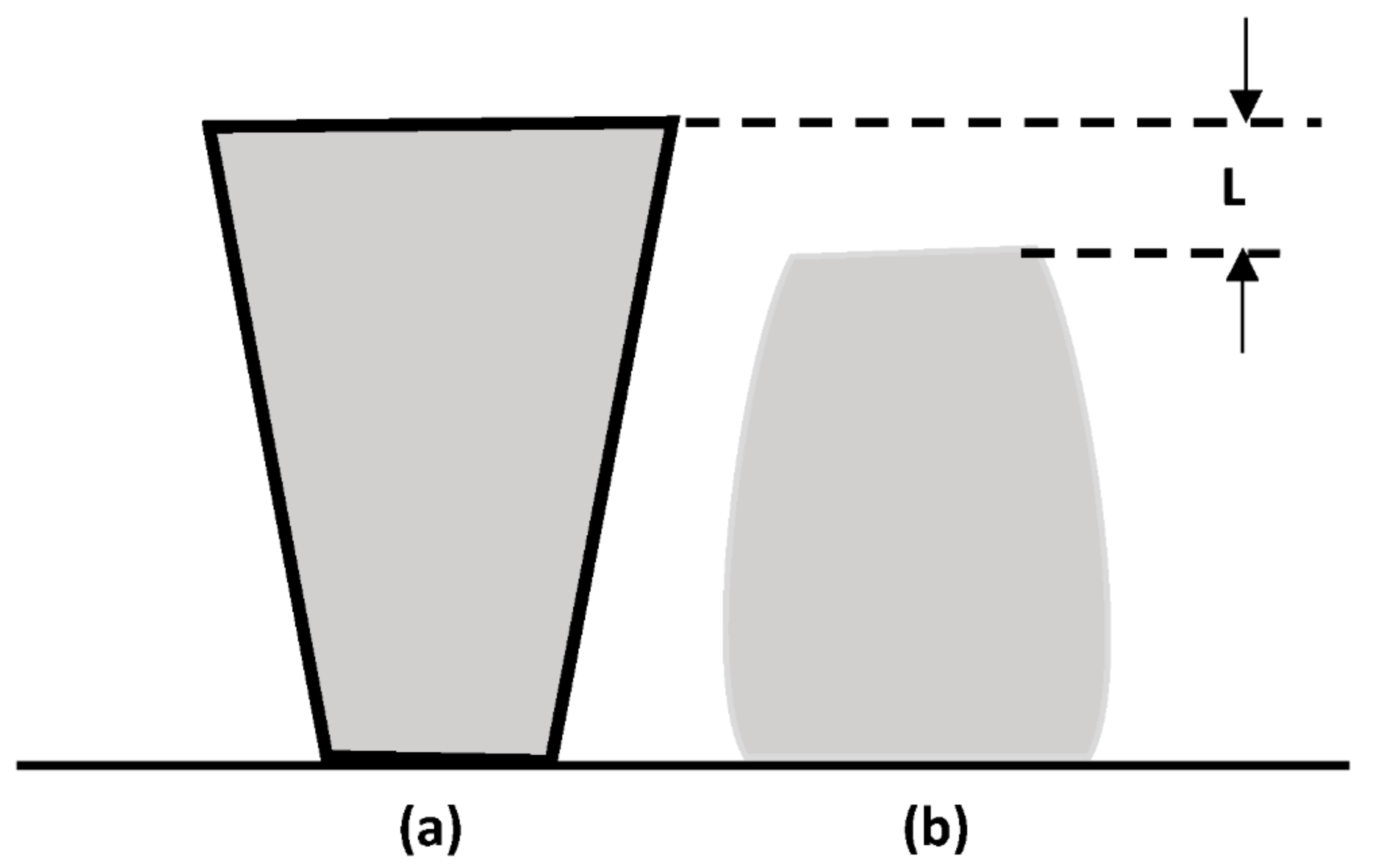
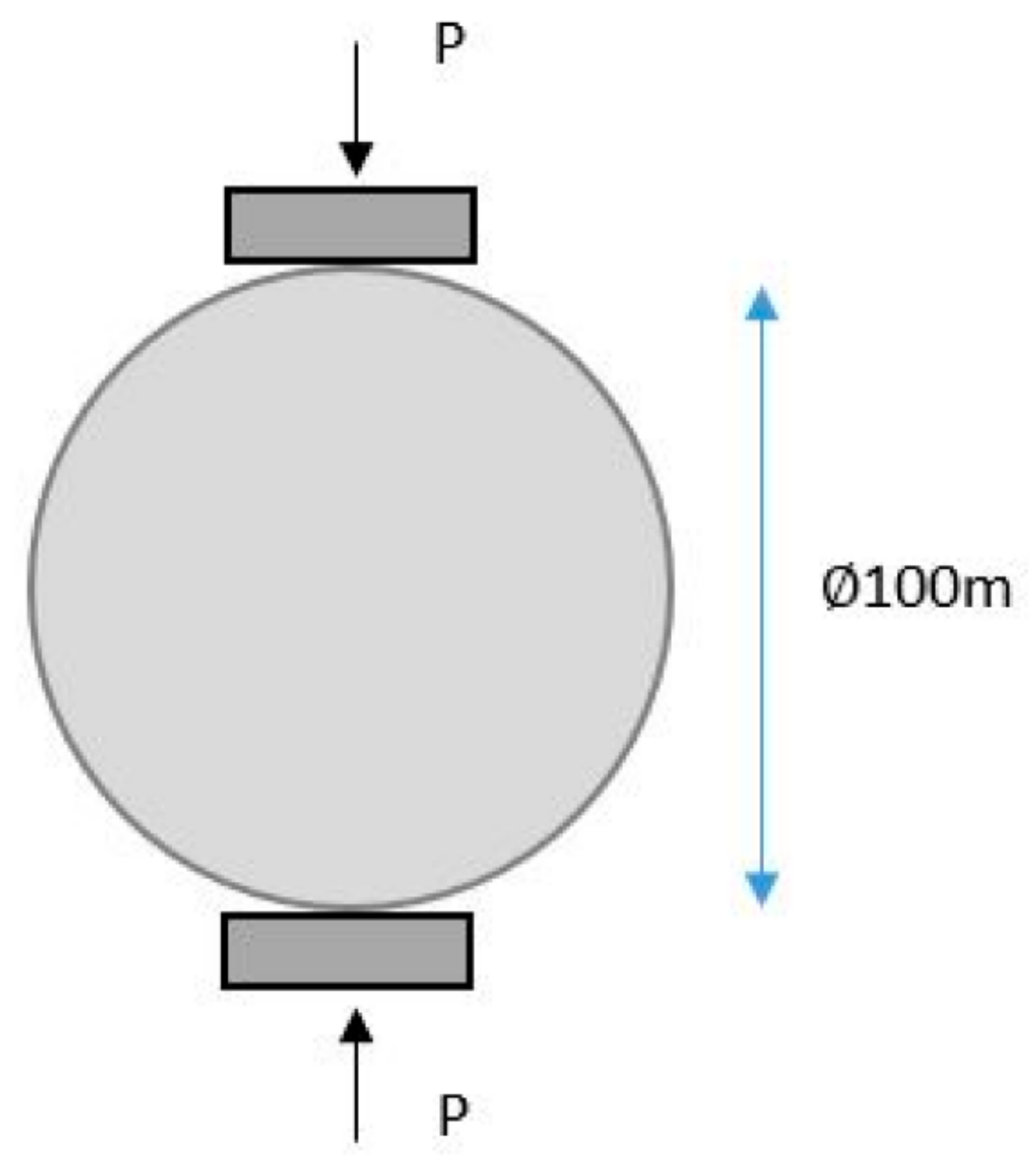

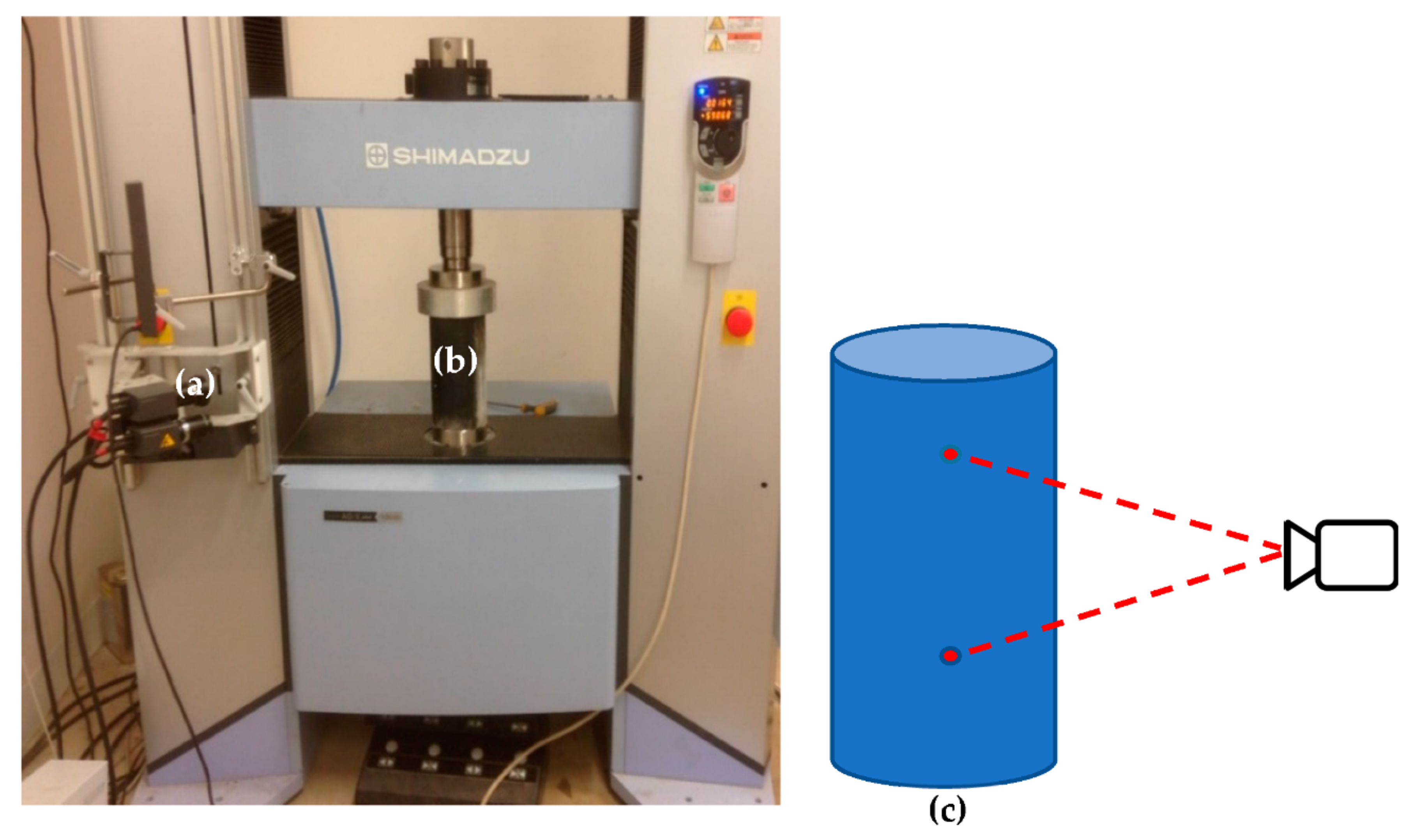
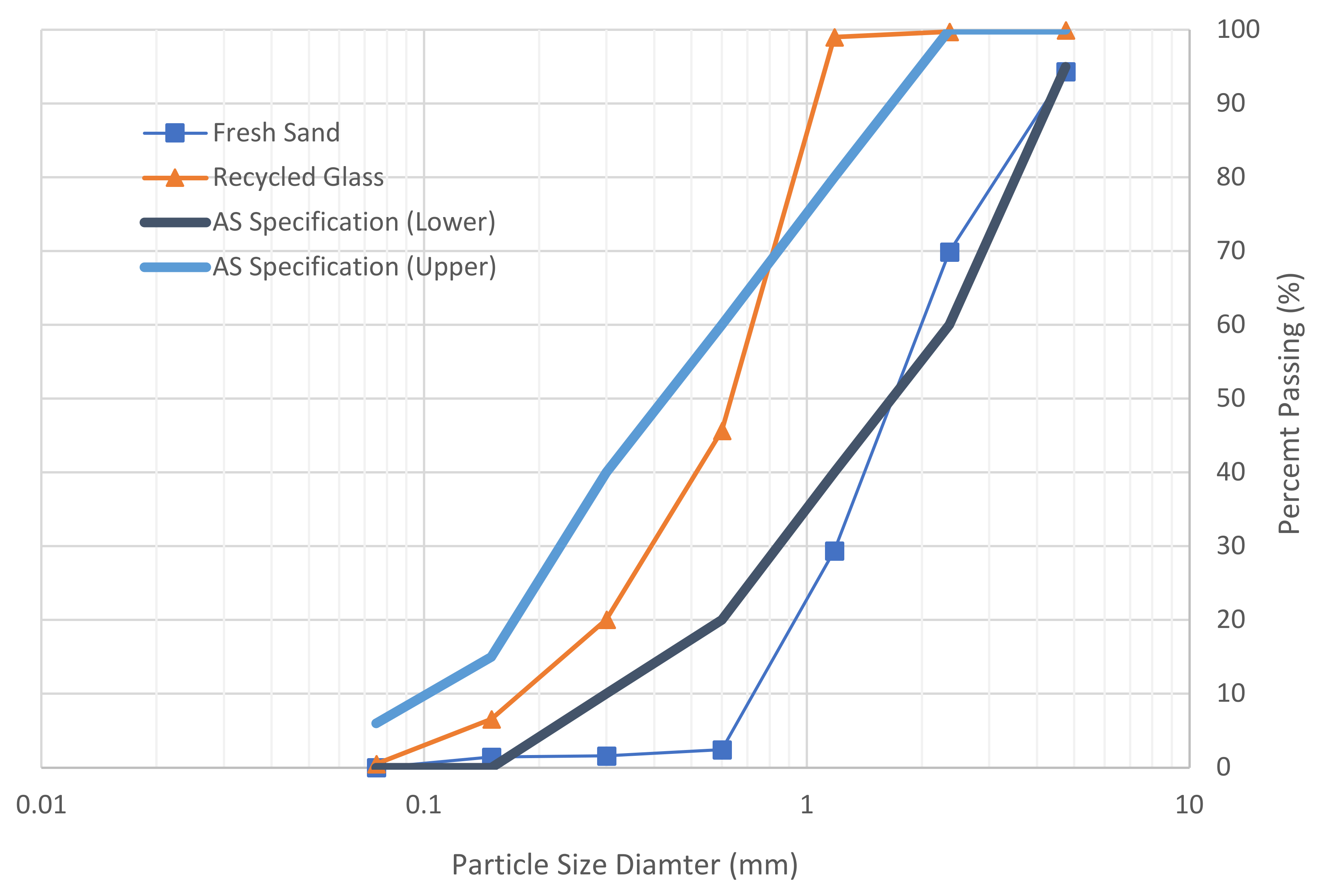
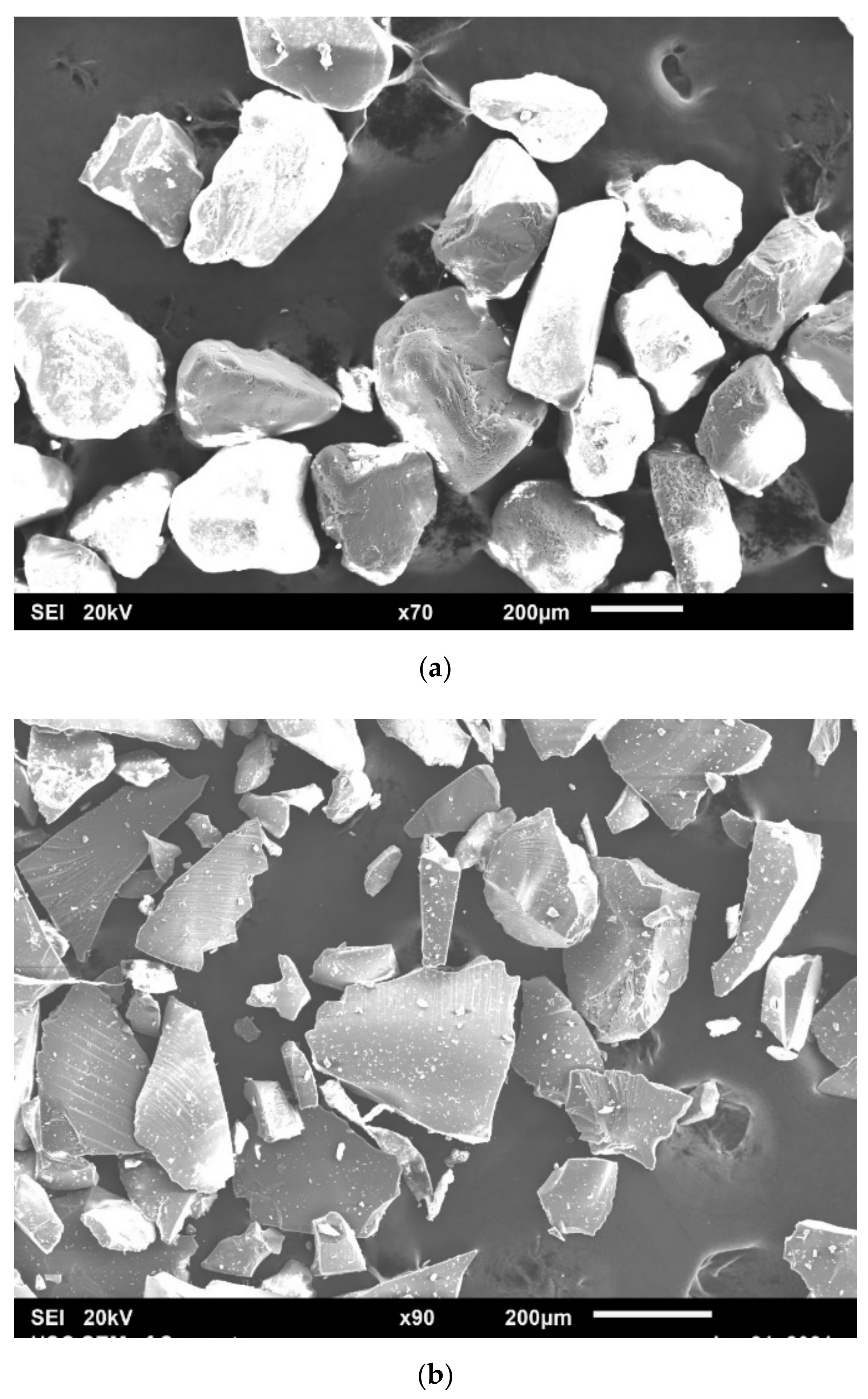
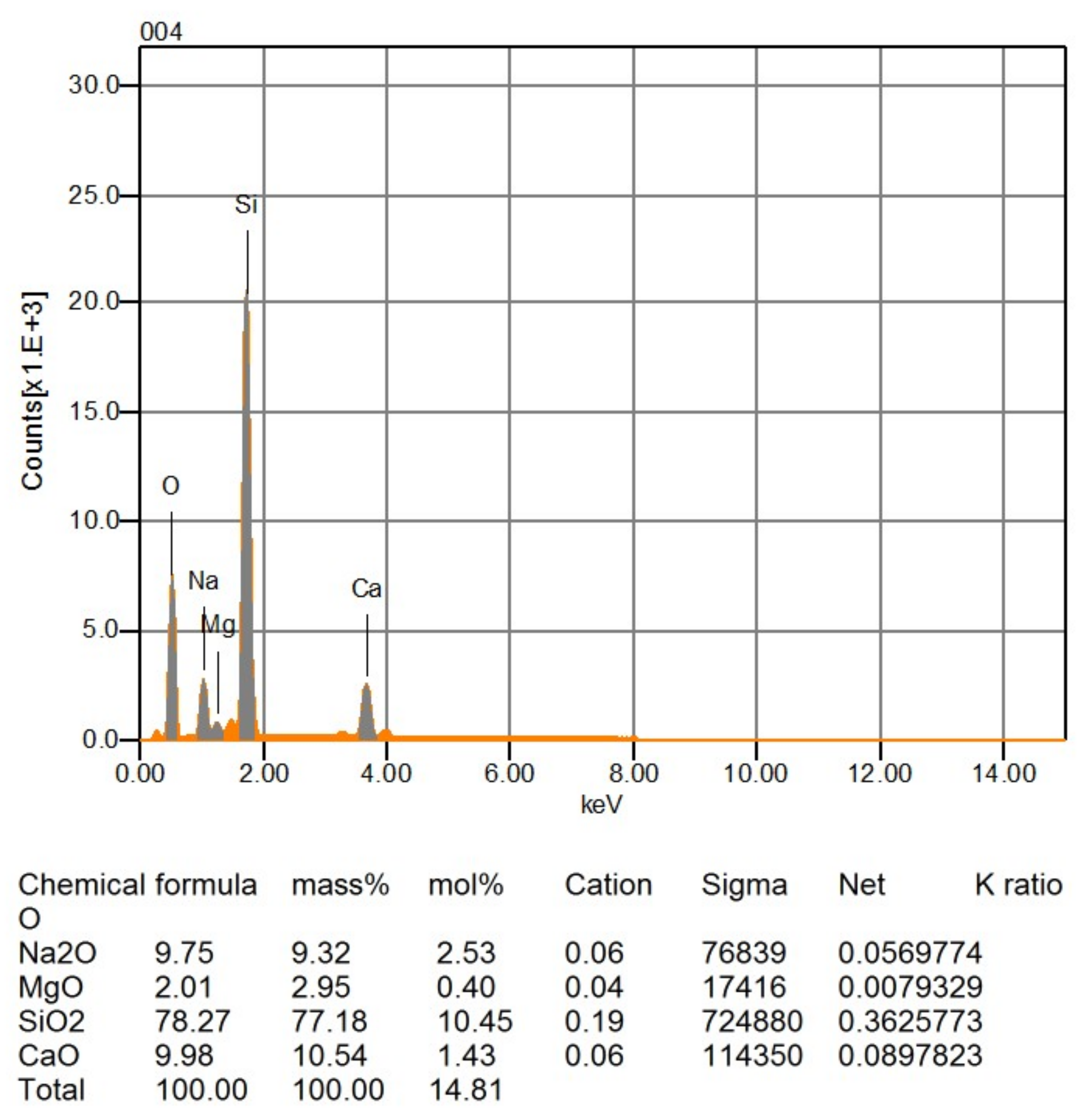
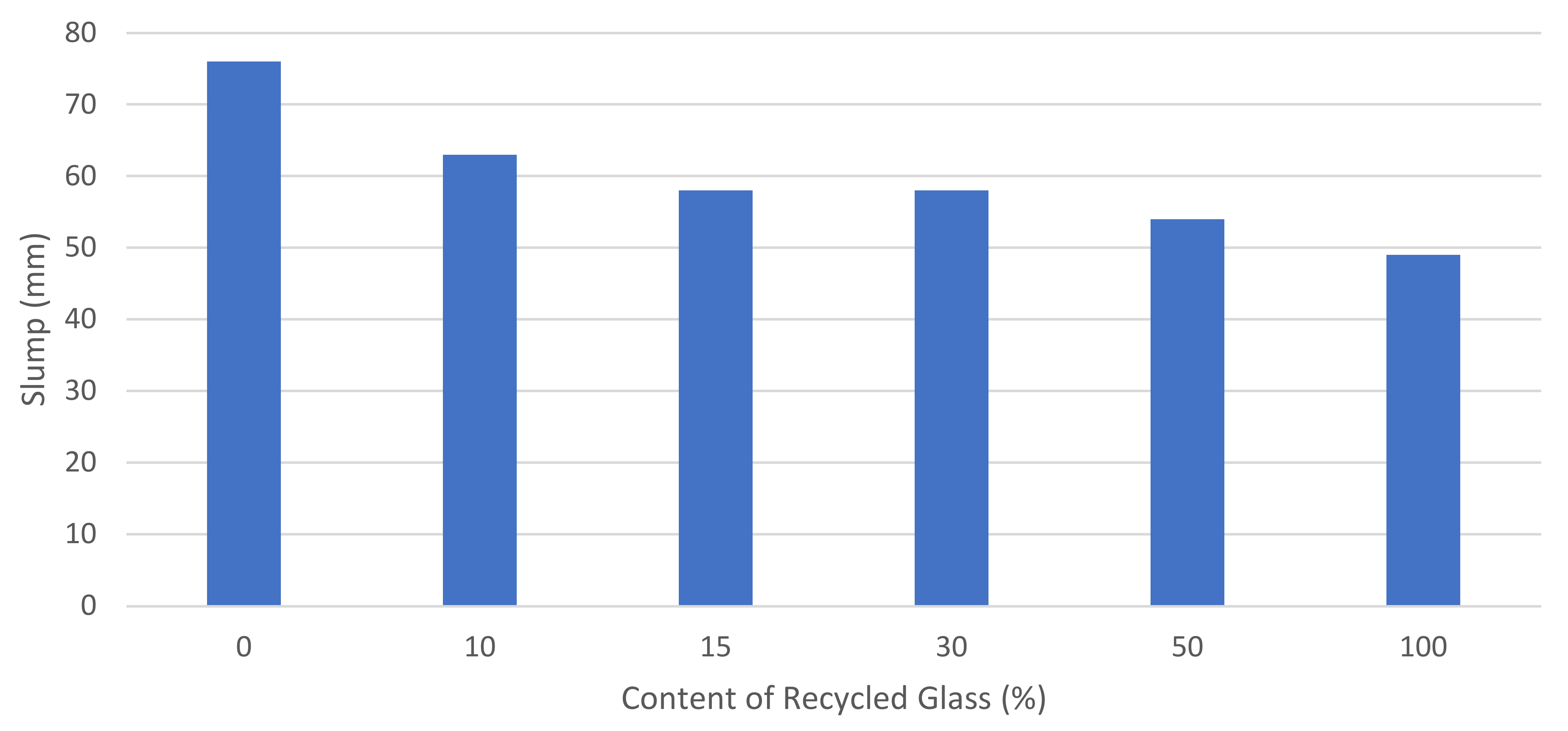
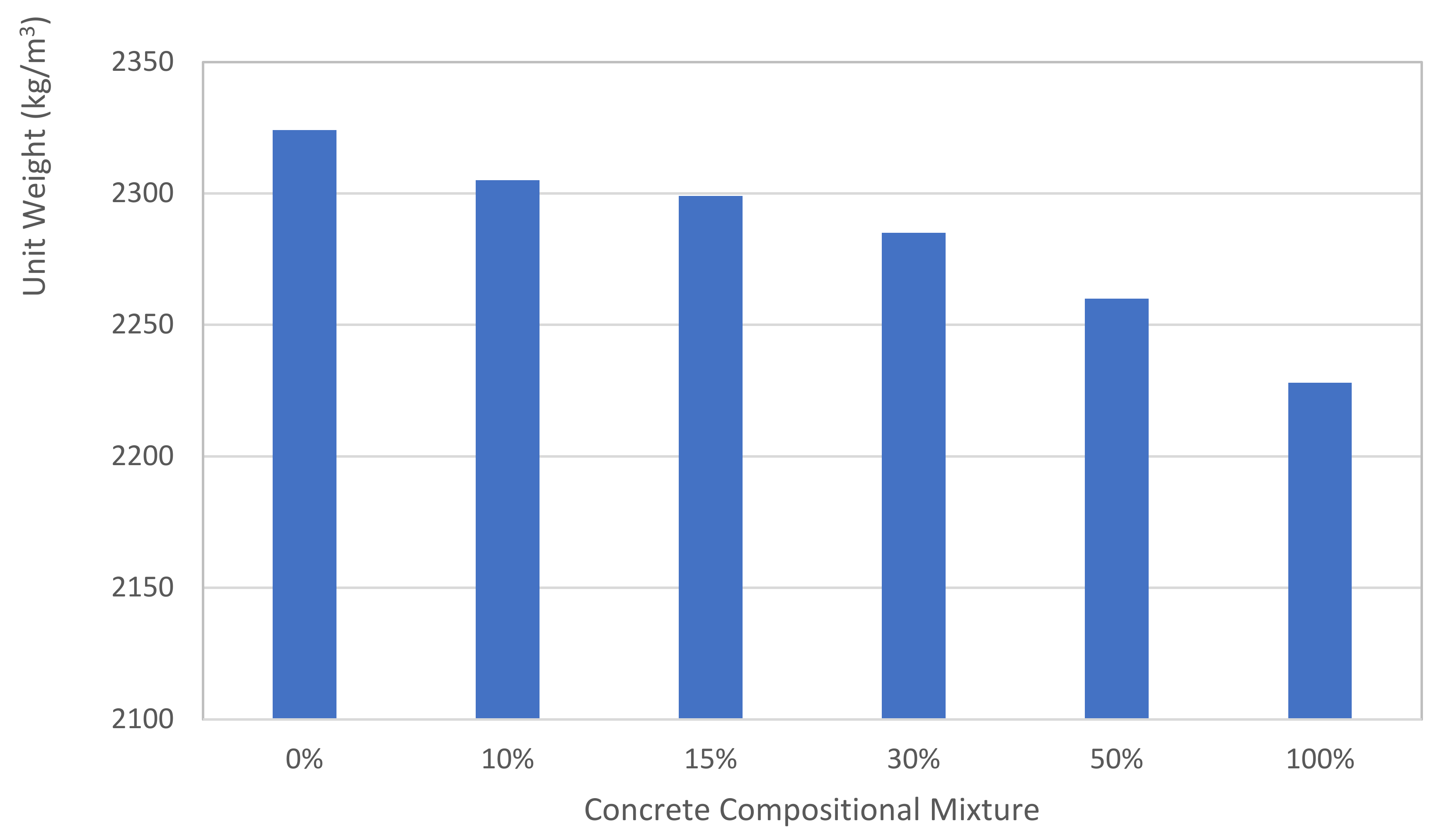
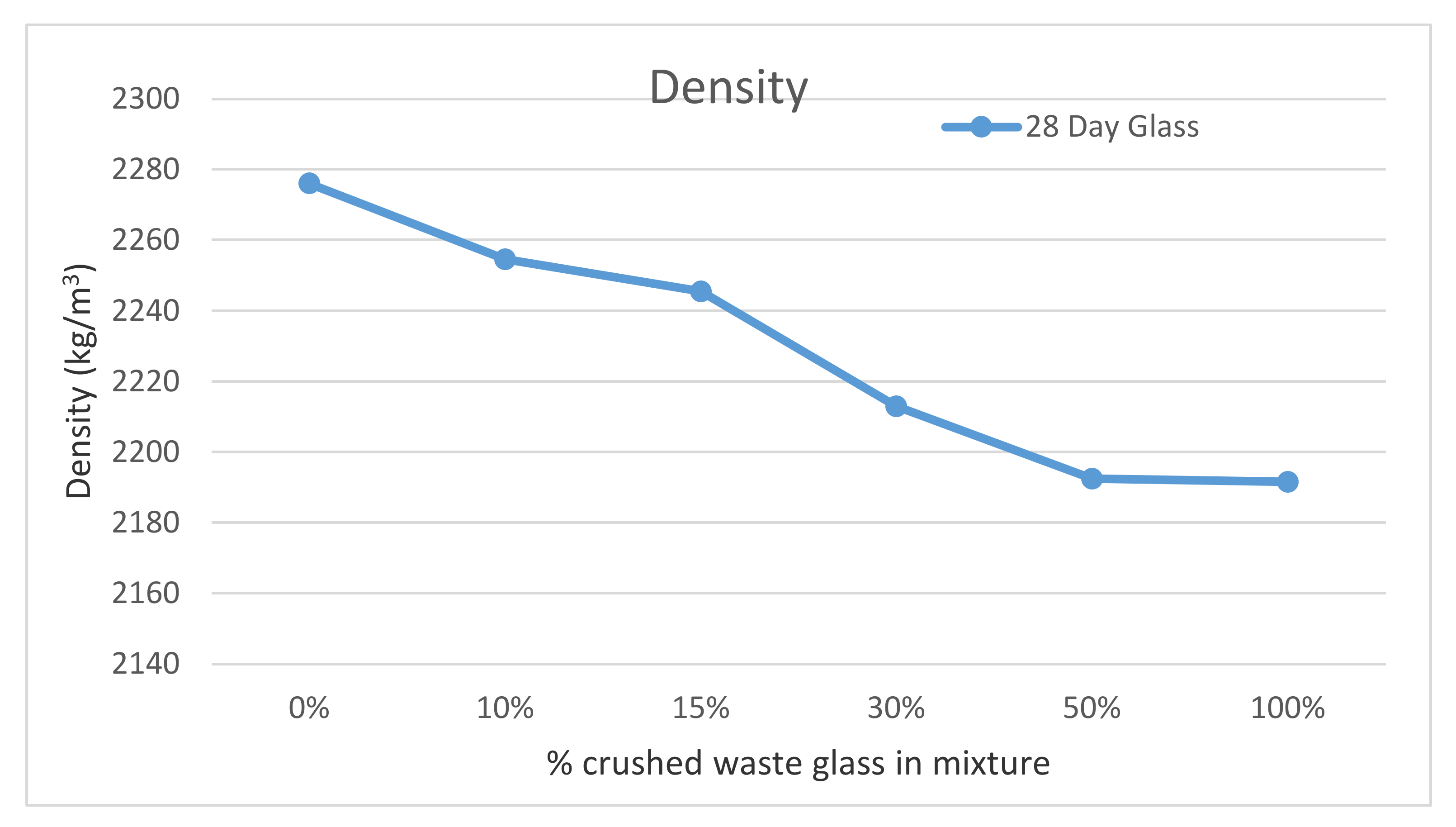
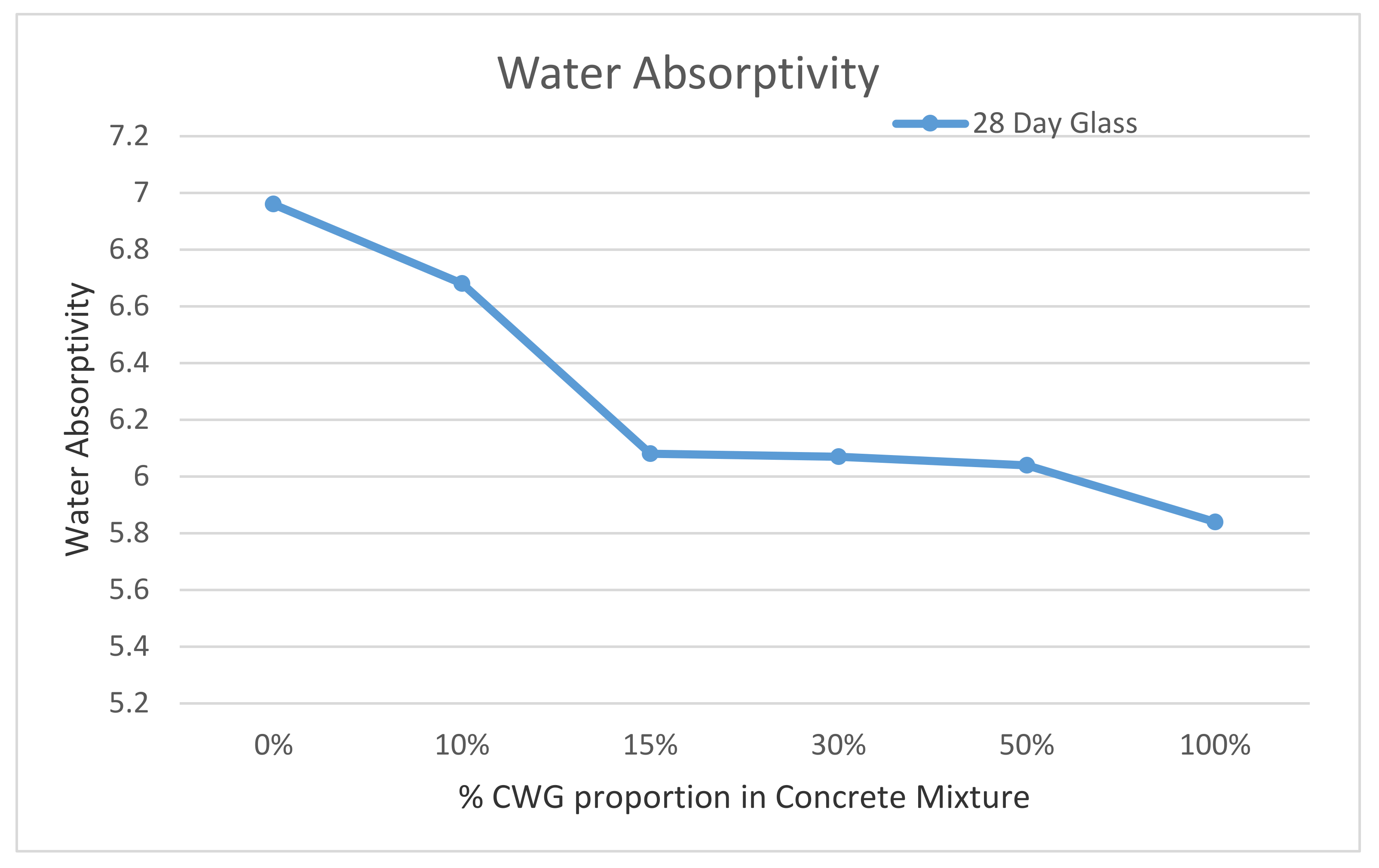

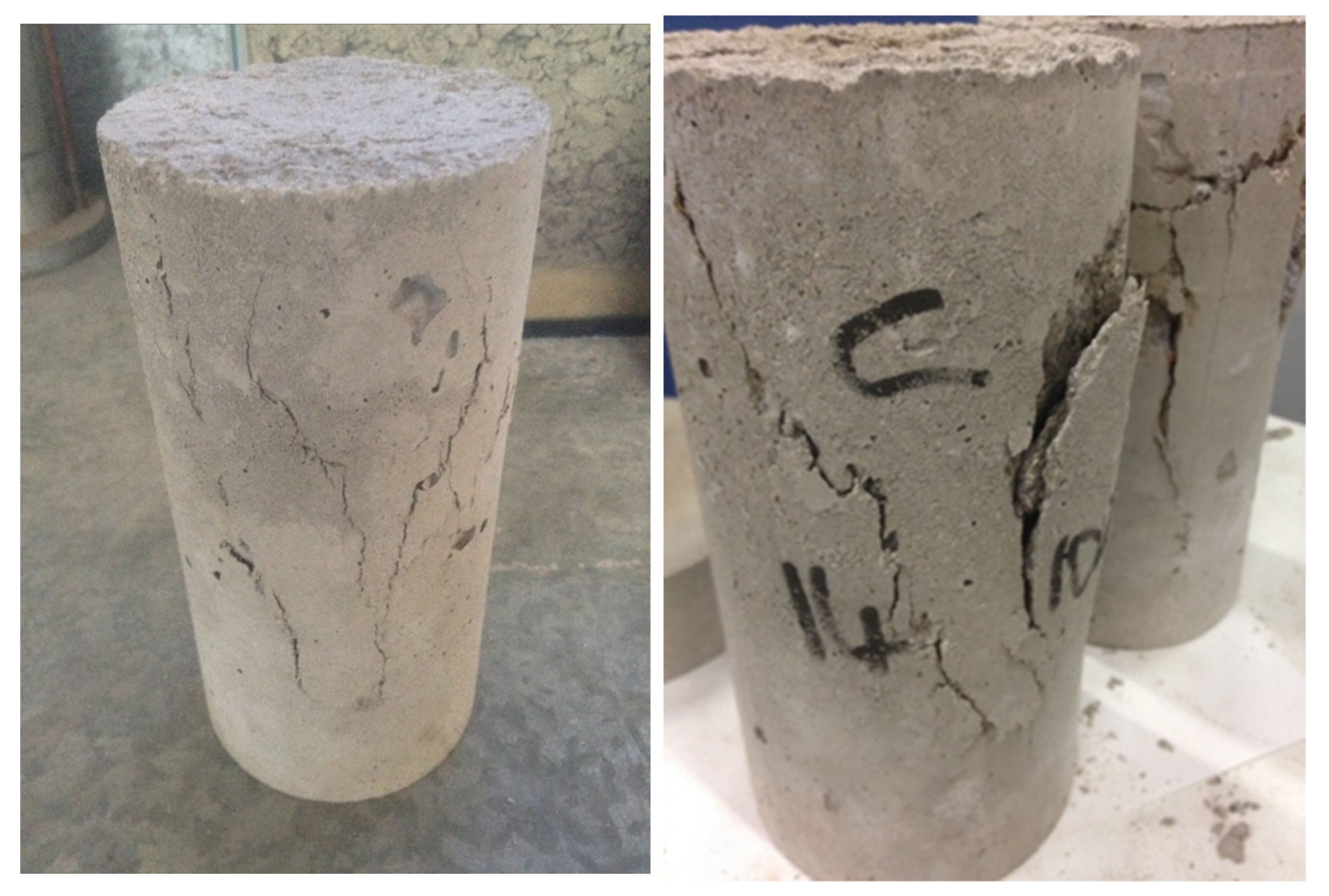
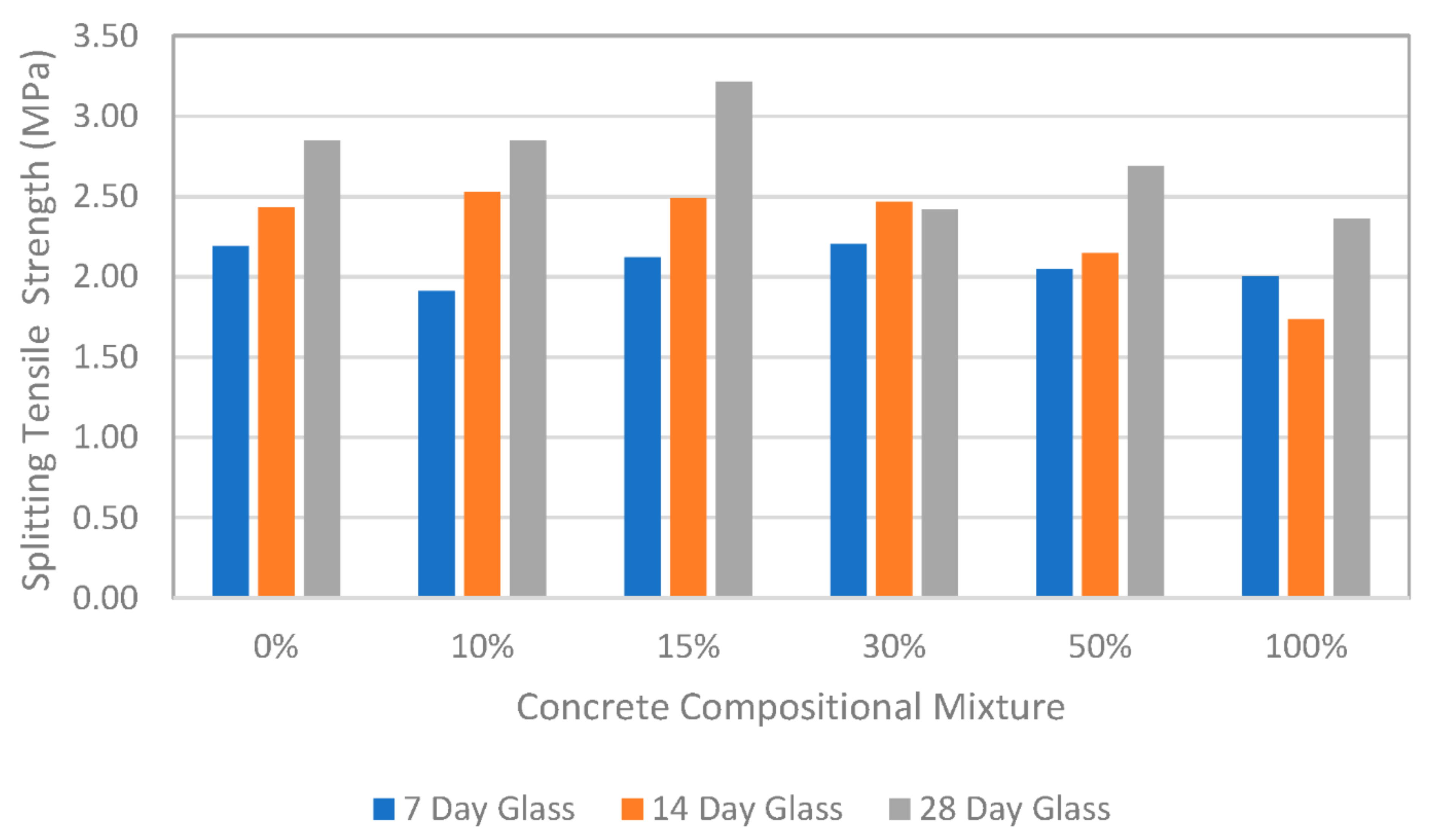
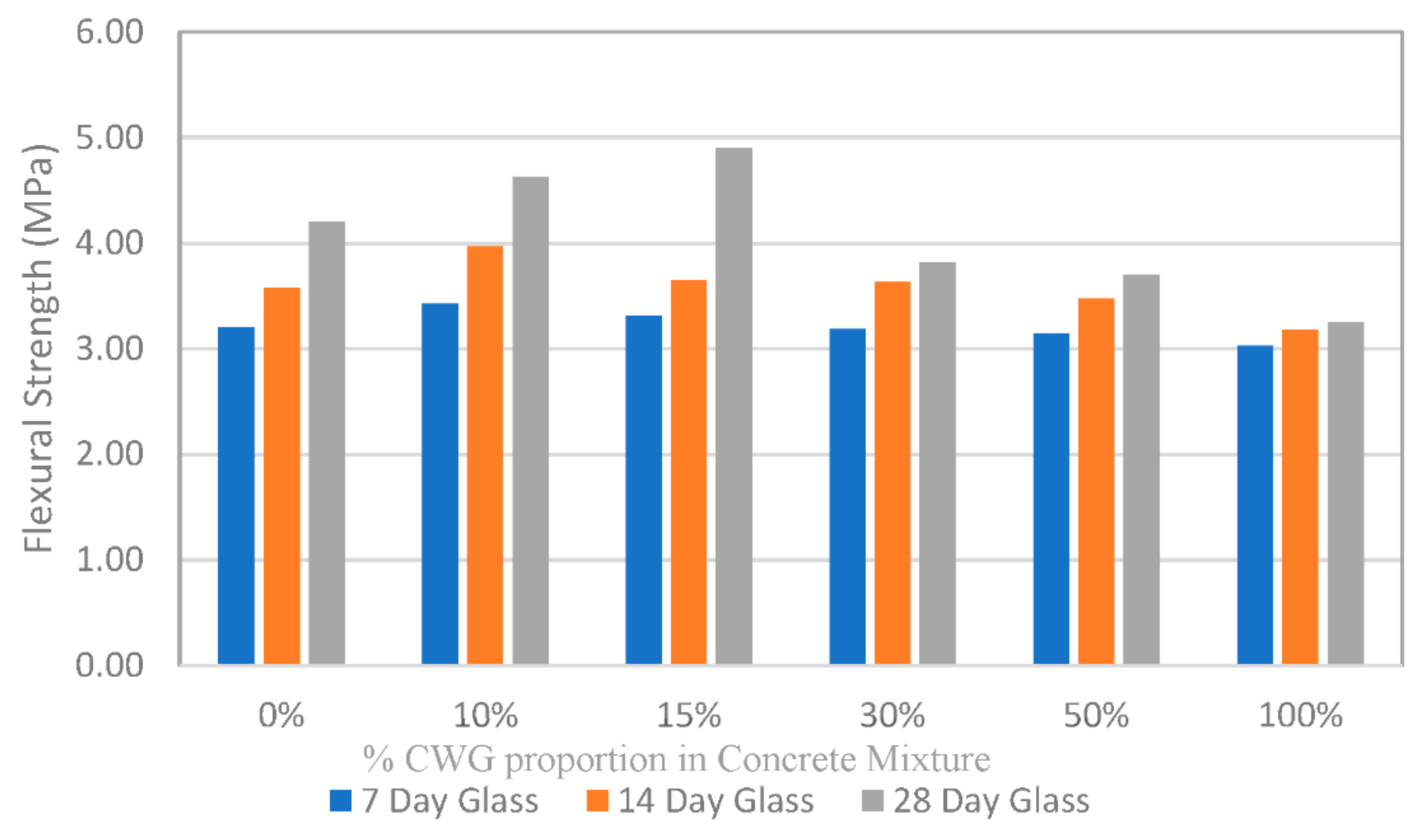
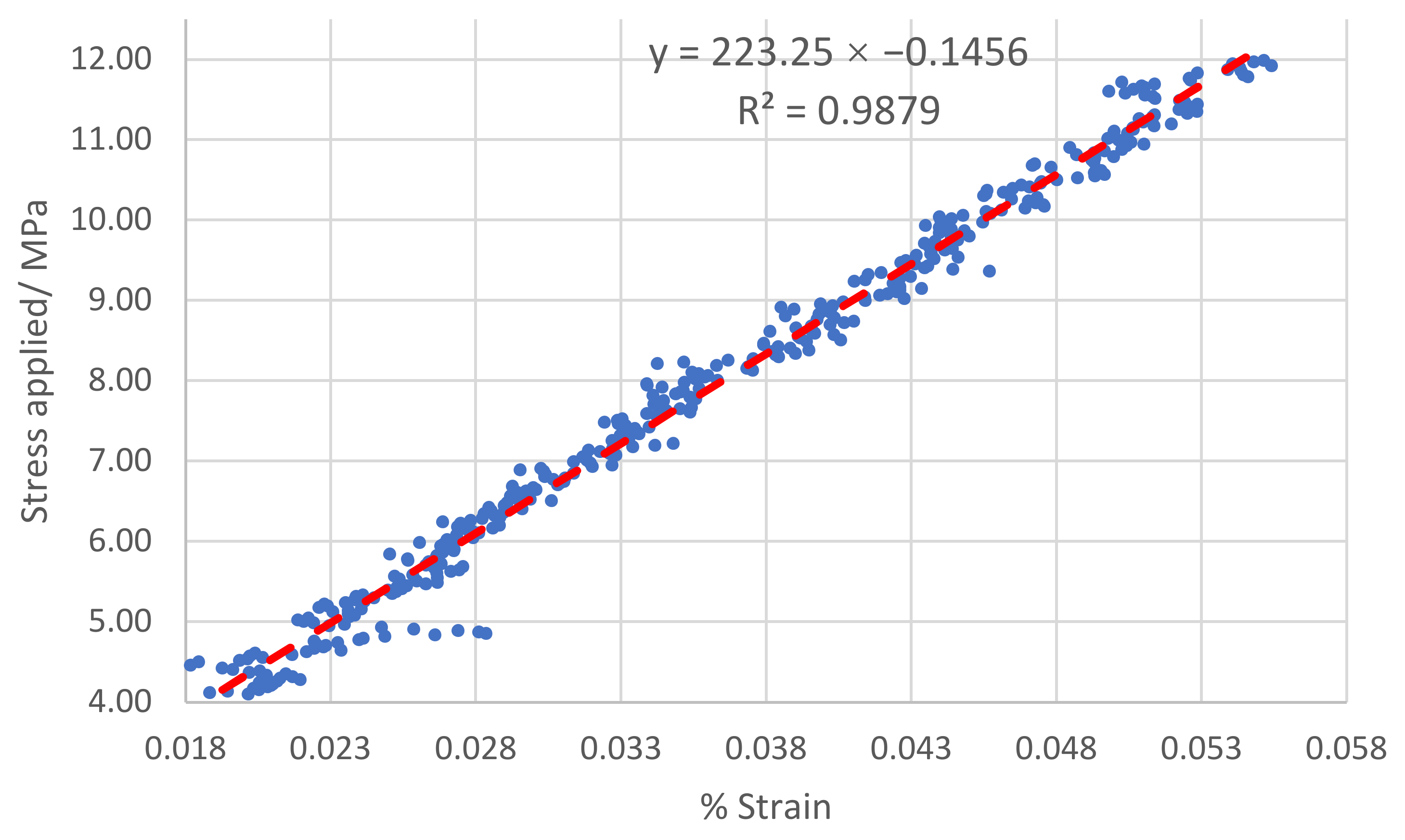
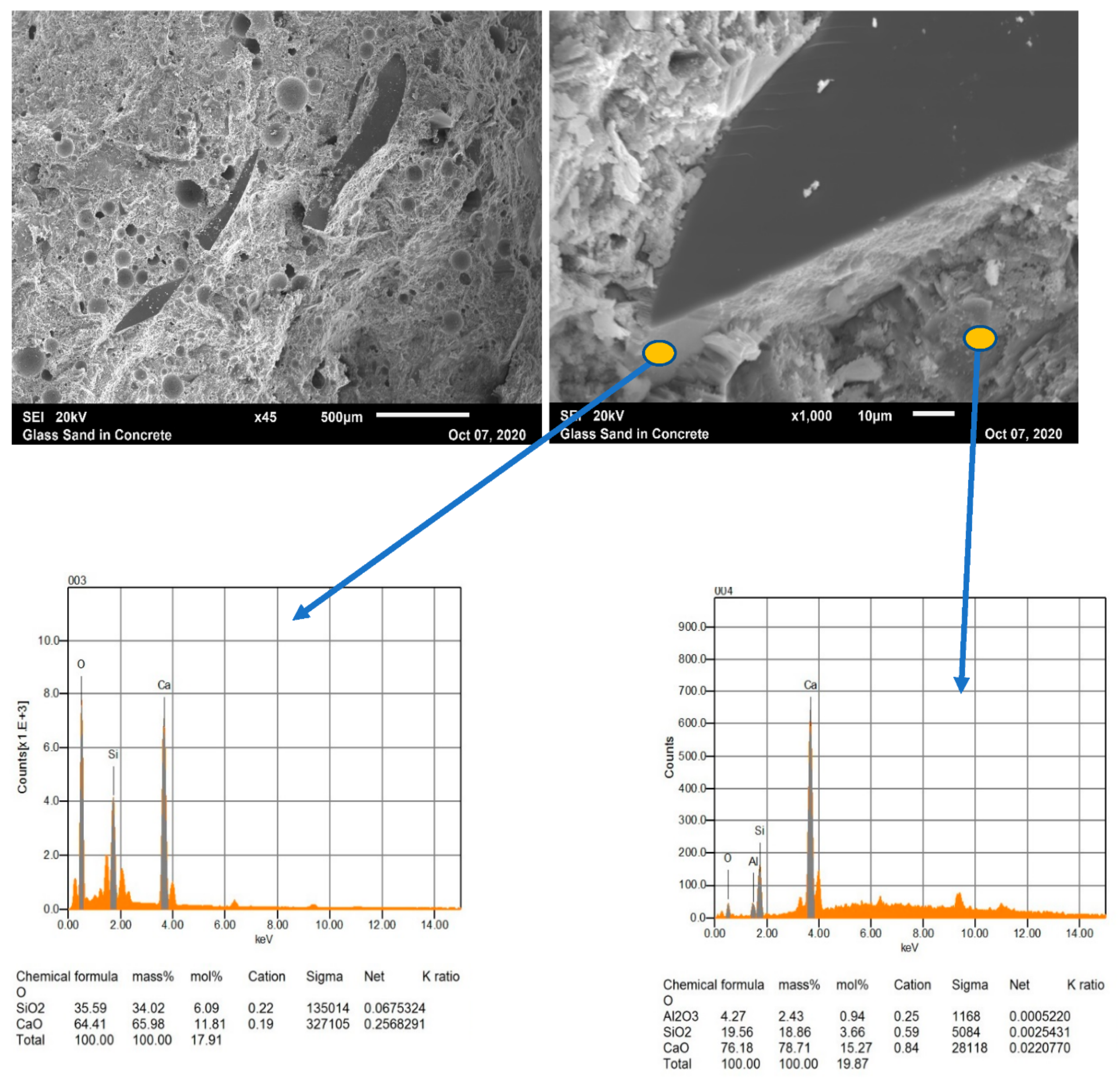

| Composition | Cement | Coarse Aggregate | Sand | Recycled Glass |
|---|---|---|---|---|
| Replacement % | Kg | Kg | Kg | Kg |
| 0 | 320 | 1280 | 800 | 0 |
| 10 | 320 | 1280 | 720 | 80 |
| 15 | 320 | 1280 | 680 | 120 |
| 30 | 320 | 1280 | 560 | 240 |
| 50 | 320 | 1280 | 400 | 400 |
| 100 | 320 | 1280 | 0 | 800 |
| Mixture | 28 Days |
|---|---|
| 0% | 20 |
| 10% | 23 |
| 15% | 22 |
| 30% | 20 |
| 50% | 23.3 |
| 100% | 24 |
Publisher’s Note: MDPI stays neutral with regard to jurisdictional claims in published maps and institutional affiliations. |
© 2021 by the authors. Licensee MDPI, Basel, Switzerland. This article is an open access article distributed under the terms and conditions of the Creative Commons Attribution (CC BY) license (https://creativecommons.org/licenses/by/4.0/).
Share and Cite
Devaraj, R.; Jordan, J.; Gerber, C.; Olofinjana, A. Exploring the Effects of the Substitution of Freshly Mined Sands with Recycled Crushed Glass on the Properties of Concrete. Appl. Sci. 2021, 11, 3318. https://doi.org/10.3390/app11083318
Devaraj R, Jordan J, Gerber C, Olofinjana A. Exploring the Effects of the Substitution of Freshly Mined Sands with Recycled Crushed Glass on the Properties of Concrete. Applied Sciences. 2021; 11(8):3318. https://doi.org/10.3390/app11083318
Chicago/Turabian StyleDevaraj, Rajeev, Jonathan Jordan, Christophe Gerber, and Ayodele Olofinjana. 2021. "Exploring the Effects of the Substitution of Freshly Mined Sands with Recycled Crushed Glass on the Properties of Concrete" Applied Sciences 11, no. 8: 3318. https://doi.org/10.3390/app11083318
APA StyleDevaraj, R., Jordan, J., Gerber, C., & Olofinjana, A. (2021). Exploring the Effects of the Substitution of Freshly Mined Sands with Recycled Crushed Glass on the Properties of Concrete. Applied Sciences, 11(8), 3318. https://doi.org/10.3390/app11083318








